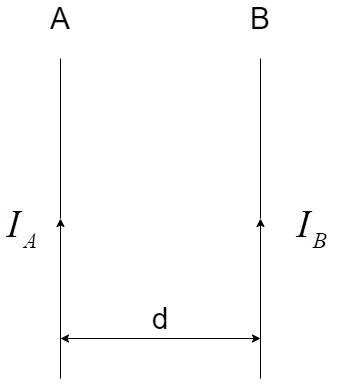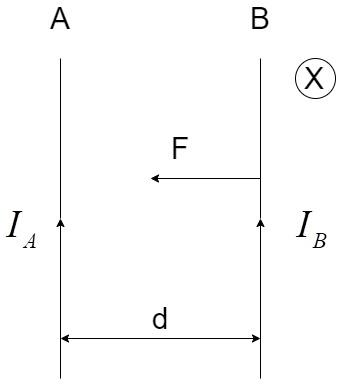
Derive the formula for the force acting between two parallel current carrying conductors.
Answer
549.9k+ views
Hint: Before we proceed to derive the expression for force acting between two current carrying parallel conductors, we should be familiar with the expression for the Biot-Savart’s law which gives the expression for magnetic field at a point due to a current carrying conductor, as follows –
$dB = \dfrac{{{\mu _0}}}{{4\pi }}\dfrac{{I \cdot dl}}{{{r^3}}}$
where I = current in the circuit, $dl$= length of the current element, r = distance of the point from the current element.
Complete step by step solution:
Consider two conductors A and B of infinite length, with currents ${I_A}$ and ${I_B}$ in the same direction and separated at a distance of d, as shown:

The current ${I_A}$ results in a magnetic field ${B_A}$ at the conductor B, at the distance of d, which is given by applying the Biot-Savart’s law for a conductor carrying current.
${B_A} = \dfrac{{{\mu _0}}}{{4\pi }}\dfrac{{2{I_A}}}{d}$
Whenever a current carrying conductor is placed in an external magnetic field, there is a force acting on it and the force experienced by the conductor is equal to the product of magnetic field, current and the length of the conductor.
$F = BIL$
The conductor B experiences force due to the magnetic field produced by the conductor A, which is given by ${B_A}$.
Therefore, the force acting on the conductor B will be equal to –
$\Rightarrow F = {B_A}{I_B}L$
Substituting the value ${B_A}$ , we have –
$\Rightarrow F = \dfrac{{{\mu _0}}}{{4\pi }}\dfrac{{2{I_A}{I_B}}}{d}L$
Therefore, the force per unit length between two parallel conductors is given by the expression:
$\Rightarrow f = \dfrac{F}{L} = \dfrac{{{\mu _0}}}{{4\pi }}\dfrac{{2{I_A}{I_B}}}{d}$
The direction of the force can be calculated by using the Fleming’s Left Hand rule where:
i) Index finger represents the direction of the magnetic field, B
ii) Middle finger represents the direction of the current, I
iii) Thumb represents the direction of the force, F
The direction of the force is represented in the diagram below:

Here, the direction of ${B_A}$is calculated by the Right-Hand screw rule, which gives the result that the direction of the magnetic field is inside the plane of paper and denoted by X.
Note: The standard definition of the SI unit of current, ampere is defined by the help of the derived expression as follows:
If ${I_A} = {I_B} = 1A$ and $d = 1m$, we have –
$\Rightarrow f = \dfrac{{{\mu _0}}}{{4\pi }}\dfrac{{2{I_A}{I_B}}}{d} = {10^{ - 7}} \times \dfrac{{2 \times 1 \times 1}}{1} = 2 \times {10^{ - 7}}N$
Thus, One ampere is defined as the steady current, which when maintained between two infinitely long conductors with unit separation, would produce a force per unit length equal to $2 \times {10^{ - 7}}N$.
$dB = \dfrac{{{\mu _0}}}{{4\pi }}\dfrac{{I \cdot dl}}{{{r^3}}}$
where I = current in the circuit, $dl$= length of the current element, r = distance of the point from the current element.
Complete step by step solution:
Consider two conductors A and B of infinite length, with currents ${I_A}$ and ${I_B}$ in the same direction and separated at a distance of d, as shown:

The current ${I_A}$ results in a magnetic field ${B_A}$ at the conductor B, at the distance of d, which is given by applying the Biot-Savart’s law for a conductor carrying current.
${B_A} = \dfrac{{{\mu _0}}}{{4\pi }}\dfrac{{2{I_A}}}{d}$
Whenever a current carrying conductor is placed in an external magnetic field, there is a force acting on it and the force experienced by the conductor is equal to the product of magnetic field, current and the length of the conductor.
$F = BIL$
The conductor B experiences force due to the magnetic field produced by the conductor A, which is given by ${B_A}$.
Therefore, the force acting on the conductor B will be equal to –
$\Rightarrow F = {B_A}{I_B}L$
Substituting the value ${B_A}$ , we have –
$\Rightarrow F = \dfrac{{{\mu _0}}}{{4\pi }}\dfrac{{2{I_A}{I_B}}}{d}L$
Therefore, the force per unit length between two parallel conductors is given by the expression:
$\Rightarrow f = \dfrac{F}{L} = \dfrac{{{\mu _0}}}{{4\pi }}\dfrac{{2{I_A}{I_B}}}{d}$
The direction of the force can be calculated by using the Fleming’s Left Hand rule where:
i) Index finger represents the direction of the magnetic field, B
ii) Middle finger represents the direction of the current, I
iii) Thumb represents the direction of the force, F
The direction of the force is represented in the diagram below:

Here, the direction of ${B_A}$is calculated by the Right-Hand screw rule, which gives the result that the direction of the magnetic field is inside the plane of paper and denoted by X.
Note: The standard definition of the SI unit of current, ampere is defined by the help of the derived expression as follows:
If ${I_A} = {I_B} = 1A$ and $d = 1m$, we have –
$\Rightarrow f = \dfrac{{{\mu _0}}}{{4\pi }}\dfrac{{2{I_A}{I_B}}}{d} = {10^{ - 7}} \times \dfrac{{2 \times 1 \times 1}}{1} = 2 \times {10^{ - 7}}N$
Thus, One ampere is defined as the steady current, which when maintained between two infinitely long conductors with unit separation, would produce a force per unit length equal to $2 \times {10^{ - 7}}N$.
Recently Updated Pages
A man running at a speed 5 ms is viewed in the side class 12 physics CBSE

The number of solutions in x in 02pi for which sqrt class 12 maths CBSE

State and explain Hardy Weinbergs Principle class 12 biology CBSE

Write any two methods of preparation of phenol Give class 12 chemistry CBSE

Which of the following statements is wrong a Amnion class 12 biology CBSE

Differentiate between action potential and resting class 12 biology CBSE

Trending doubts
What are the major means of transport Explain each class 12 social science CBSE

Which are the Top 10 Largest Countries of the World?

Draw a labelled sketch of the human eye class 12 physics CBSE

How much time does it take to bleed after eating p class 12 biology CBSE

Explain sex determination in humans with line diag class 12 biology CBSE

Explain sex determination in humans with the help of class 12 biology CBSE




